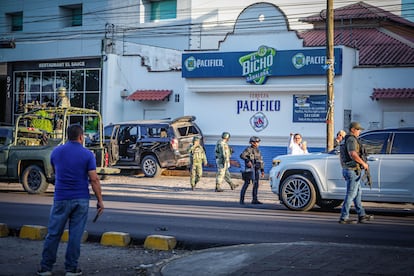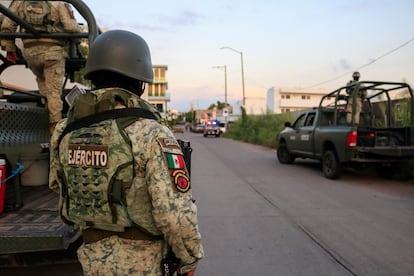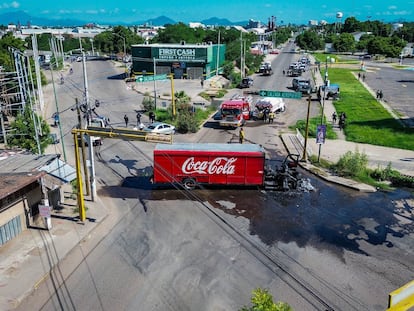The trail of El Mayo and Los Chapitos in Sinaloa: Narco-blockades, executions and more than 50 dead
The biggest fracture within the Sinaloa Cartel in more than a decade is causing panic in the state

A military unit was patrolling the dirt roads of the El Barrio neighborhood in eastern Culiacán early in the morning of September 17 when they found the bodies of two men who had been executed. Their corpses were found face down in a puddle, wrapped in blankets, with signs of torture. Toy cars and a yellow plastic tray were placed on top of their bodies, according to witnesses and local journalists. Just two days earlier, five people were found murdered, all with their hands tied behind their backs and with small hats placed on their heads, on Mexico Highway 15. A scene almost identical in nature was discovered on September 22, on the same stretch of road, which has become the epicenter of violence between warring factions of the Sinaloa Cartel.
Since September 9, allies of Ismael “El Mayo” Zambada and Los Chapitos, led by the sons of El Mayo’s former partner, Joaquín “El Chapo” Guzmán, have turned Sinaloa into a war zone. The biggest fracture within the Sinaloa Cartel in more than a decade has resulted in at least 53 homicides and dozens of missing, wounded, and detained, according to official data. Neither the local population nor the authorities are able to anticipate when the conflict will end, or how far it will go.
EL PAÍS has pinpointed the location of each of the murders reported by the police and the State Prosecutor’s Office up to September 20, and has compiled the violent deaths reported by federal forces to get a clearer picture of the crisis that is ravaging the state, and the trail of destruction left by the cartels. Over the two weeks previous to last Friday, there were as many homicides as in the previous five weeks. Three out of four victims were killed in Culiacán and its surrounding municipalities, the historic stronghold of the Sinaloa Cartel. And although the hostilities are concentrated in the state capital, violent incidents have been widespread in recent weeks, with over 135 miles between the two furthest points where a murder has been reported.

Delayed revenge
July 25 was the day everything changed in Sinaloa. El Mayo, who had never set foot in jail in more than five decades of criminal activity, landed unexpectedly at a small rural airport in New Mexico along with Joaquín Guzmán López, one of El Chapo’s sons. The 76-year-old capo was captured without a shot being fired and without the governments of either country being able to provide a convincing explanation about the circumstances surrounding his arrest. Amid the confusion, El Mayo published a letter on August 10 in which he claimed that he was betrayed by Guzmán López, his godson, and handed over against his will to the United States, after being summoned to a meeting with Sinaloa Governor Rubén Rocha and opposition leader Héctor Cuén, a former rector of the Autonomous University of Sinaloa and an elected federal deputy. Cuén was murdered on the same day of El Mayo’s arrest. Guzmán López was named as the main suspect in the kidnapping of El Mayo by Mexican authorities on August 21. None of these events, however, translated into an immediate increase in murders in Sinaloa.
“I call on the people of Sinaloa to use restraint and maintain peace in our State,” wrote El Mayo. “Nothing can be solved by violence.” The revenge was prepared slowly. Shortly before a month had passed since El Mayo’s capture, Governor Rocha admitted that 10 members of both sides — seven loyal to El Mayo and three to Los Chapitos — had been killed in sporadic events, but there were no signs of an open conflict.
The first warning of rising tensions came on August 29. An attack by “armed civilians” against a military patrol in the municipality of Jesús María, a key territory for Los Chapitos, fueled fears of a new Culiacanazo, as the episodes of extreme violence that affected the city after separate operations to capture Ovidio “El Ratón” Guzmán, Guzmán López’s younger brother, in 2019 and 2023 are known. That same day, the Attorney General’s Office hinted that El Ratón could have been involved in the kidnapping of El Mayo. Despite the panic, there were only two murders that day. “Everything is calm,” Rocha declared a day later.
The outbreak of war
It was another attack on the Armed Forces that set alarm bells ringing in Sinaloa. On the morning of September 9, a shootout between civilians and soldiers in the La Campiña neighborhood, east of Culiacán, forced the suspension of classes in that sector of the city. Until that moment, the governor still claimed that it was an isolated incident and that “there had been no casualties.” Hours later, it was announced that a sergeant had died after being taken to hospital, and another officer had been injured.
But the violence did not stop there. A man was found shot dead in the Simón Bolívar neighborhood. Another was shot dead on Mexico Highway 15, near the municipality of Costa Rica, also part of Culiacán. In the Villa Satélite neighborhood, a man was shot dead after being chased with a handgun. And another man was found dead and tied up in the community of Portaceli, in the municipality of Eldorado, over 40 miles from the capital. There were only three homicides registered in the official bulletin board of the federal authorities.
The beginning of the war was also marked by the silence of the state authorities, who took three days to provide a detailed report of the violence and who have presented inconsistent figures between those reported by the three levels of government, and even by the Attorney General’s Office and the local police. The federal forces took even longer. It was not until September 17 that the Secretary of National Defense, Luis Cresencio Sandoval, acknowledged 13 cartel-related attacks against military convoys in Sinaloa. The preliminary toll was two soldiers dead and nine wounded, as well as more than 30 civilians killed. An officer was killed in another attack on September 16 in La Campiña, the area where it all began.
“We were monitoring for five weeks and there was no activity that indicated a confrontation, or preparation for a confrontation. In the sixth week, we did start to have data, which led us to increase reinforcements,” said Sandoval. One hypothesis that has gained traction to explain the delayed effect of the violence is that El Mayo’s group armed itself and sealed alliances with other factions before launching an attack on Los Chapitos.
The outcome of the clashes with law enforcement is also a testament to the firepower of the warring factions. An attack against the National Guard resulted in five assault rifles and more than 2,100 rounds of ammunition being seized and three arrests on September 15. In other operations, drones, armored vehicles, tire-punching devices, grenade launchers, anti-materiel rifles and drugs such as methamphetamine, cocaine, and marijuana have been seized. The Sinaloa Public Security Secretariat has seized 120 weapons, 30,000 rounds of ammunition of different calibers and 75 vehicles as of last Friday, and arrested over 40 people.
The Armed Forces have deployed more than 2,200 reinforcements in recent weeks and have focused their strategy on containment: preventing clashes and avoiding confrontations. “[The end of the violence] does not depend on us, it depends on the antagonistic groups,” said Jesús Leana, commander of the third military region, in statements that revived criticism against President Andrés Manuel López Obrador’s security policy. “The security forces have not had much impact in the area,” says Mike Ballard, director of intelligence for the firm Global Guardian. “Our main concern is that this situation will continue and potentially expand beyond Sinaloa.”
Spreading violence
The first episodes of violence offered hints of the war’s flashpoints. In La Costerita, an area south of Culiacán bordering Mexico Highway 15, there have been nearly a dozen murders in the past two weeks. Last Monday, a man was killed by gunfire. On Tuesday, another man was shot to death. On Wednesday, authorities reported the discovery of three dead men, two of them decapitated and with their hands severed, under a bridge. That same day, a femicide was reported, with the victim abandoned with her hands bound. On Thursday, a man was reported shot after being kidnapped.
Mexico Highway 15, one of the main roads in the city and the country, has also become a corridor of violence, with attacks against authorities, clashes between drug traffickers, and narco-blockades. The story is repeated on other key roads such as the Culiacán-Mazatlán highway, with deaths recorded in remote towns and mountain communities, such as in the municipality of Elota. The municipality of Concordia, where there were at least five murders last week, has been besieged and cut off for days. State authorities assured that there have been no roadblocks since last Monday.
In El Barrio, where the bodies were found with toys placed on them, another man was shot to death last Wednesday and another died in the same circumstances the previous week. In the Simón Bolivar neighborhood, at least three people have been found executed in the streets near the well-known Parque 87. The war has intensified in recent days with threats and public displays of violence to intimidate enemies and instill fear in the population. Deadly attacks have been reported in the parking lot of a supermarket, in a funeral home, at a gas station, and in a hospital.
López Obrador has insisted that Sinaloa is not “out of control,” but the escalation of violence has led him to air the harshest claim he has made against the United States since the capture of El Mayo. The president said that Washington is “jointly responsible” for the fight for control of the Sinaloa Cartel, for not consulting or notifying the Mexican authorities until the arrest was made. “An explanation is required, because if we are now facing a situation of instability and confrontation in Sinaloa, it is because they made that decision, and we do not agree that Mexico should be ignored because we have the problem here,” he said.
Ballard says the “power vacuum” following El Mayo’s arrest has accelerated internal conflicts over territory, drug trafficking routes, and access to drugs and chemical precursors. The analyst cites nearby states such as Chihuahua, Durango, Sonora, and Baja California, where there have been clashes between feuding criminal groups. Last week, for example, six burned bodies and two that were riddled with bullets were found after a confrontation on a highway in southern Chihuahua between the La Línea organization — allies of Rafael Caro Quintero’s faction and the Juárez Cartel — and Los Salgueiro, veteran hitmen from Sinaloa.
The deadliest day was September 15, when 14 murders were recorded during Independence Day celebrations. But the impact of the conflict goes beyond violent deaths. It is about each and every one of the jobs that have been lost, the children who have not been able to go to school, the businesses that have remained closed, the reports of forced disappearances, the images that flood social media, the collective psychosis, the informal curfews, and the siege of crime. While the authorities try to decree normality, the war between El Mayo and Los Chapitos has already left a permanent mark on Sinaloa.
Sign up for our weekly newsletter to get more English-language news coverage from EL PAÍS USA Edition
Tu suscripción se está usando en otro dispositivo
¿Quieres añadir otro usuario a tu suscripción?
Si continúas leyendo en este dispositivo, no se podrá leer en el otro.
FlechaTu suscripción se está usando en otro dispositivo y solo puedes acceder a EL PAÍS desde un dispositivo a la vez.
Si quieres compartir tu cuenta, cambia tu suscripción a la modalidad Premium, así podrás añadir otro usuario. Cada uno accederá con su propia cuenta de email, lo que os permitirá personalizar vuestra experiencia en EL PAÍS.
¿Tienes una suscripción de empresa? Accede aquí para contratar más cuentas.
En el caso de no saber quién está usando tu cuenta, te recomendamos cambiar tu contraseña aquí.
Si decides continuar compartiendo tu cuenta, este mensaje se mostrará en tu dispositivo y en el de la otra persona que está usando tu cuenta de forma indefinida, afectando a tu experiencia de lectura. Puedes consultar aquí los términos y condiciones de la suscripción digital.
More information
Archived In
Últimas noticias
Most viewed
- Sinaloa Cartel war is taking its toll on Los Chapitos
- Oona Chaplin: ‘I told James Cameron that I was living in a treehouse and starting a permaculture project with a friend’
- Reinhard Genzel, Nobel laureate in physics: ‘One-minute videos will never give you the truth’
- Why the price of coffee has skyrocketed: from Brazilian plantations to specialty coffee houses
- Silver prices are going crazy: This is what’s fueling the rally











































